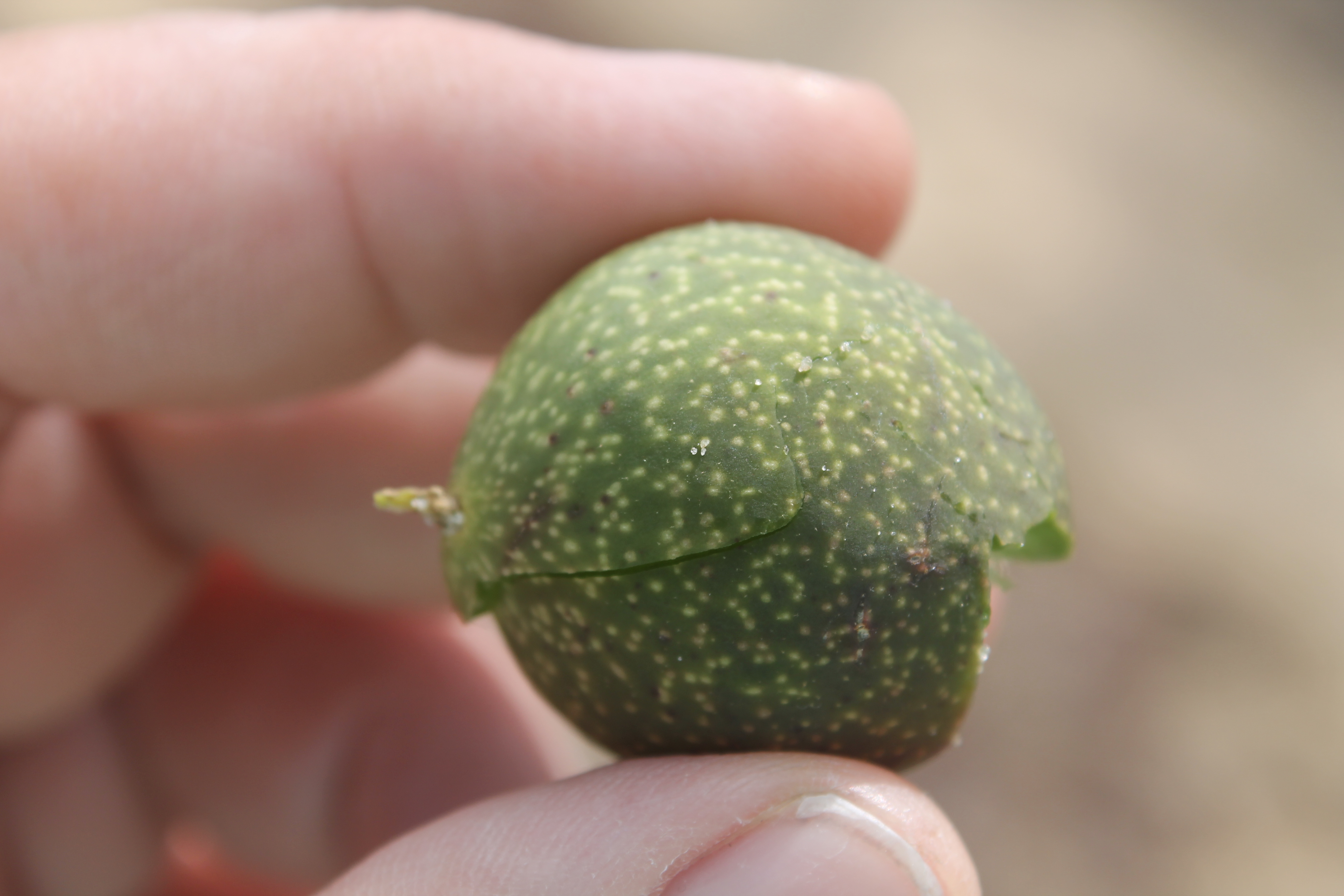
by Matthew Orwat | Jul 23, 2018
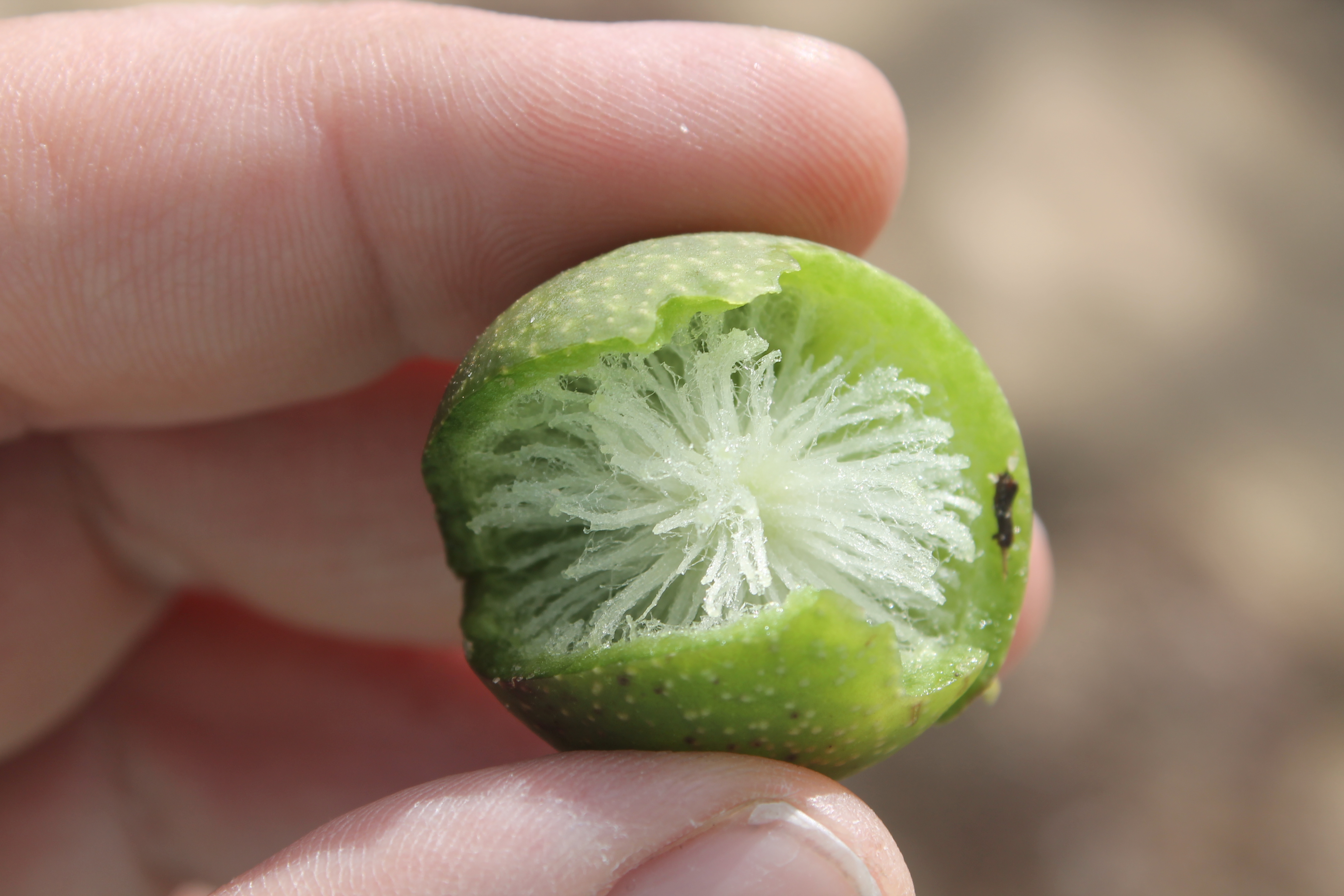
Gall caused by a wasp in the Cynipidae on Water Oak.
Humans usually believe that we have a mastery of the natural world, and know everything about it. More often than not, nature tricks us with illusions that play on our pre-conceived notions about plant life. We are conditioned to believe that everything hanging from a tree must be a fruit or nut of some sort, so much so that a wasp gall hanging from a common water oak can change our perception of that plant, making us think that it is a rare or unusual species of plant we have never seen before.
Several different species of wasps in the family Cynipidae (at least 50 different species in the continent of North America) produce fruit-like galls on various species of oaks, which are also known as oak apples. They are green or brown, depending on the species that created them, and largely hollow inside.
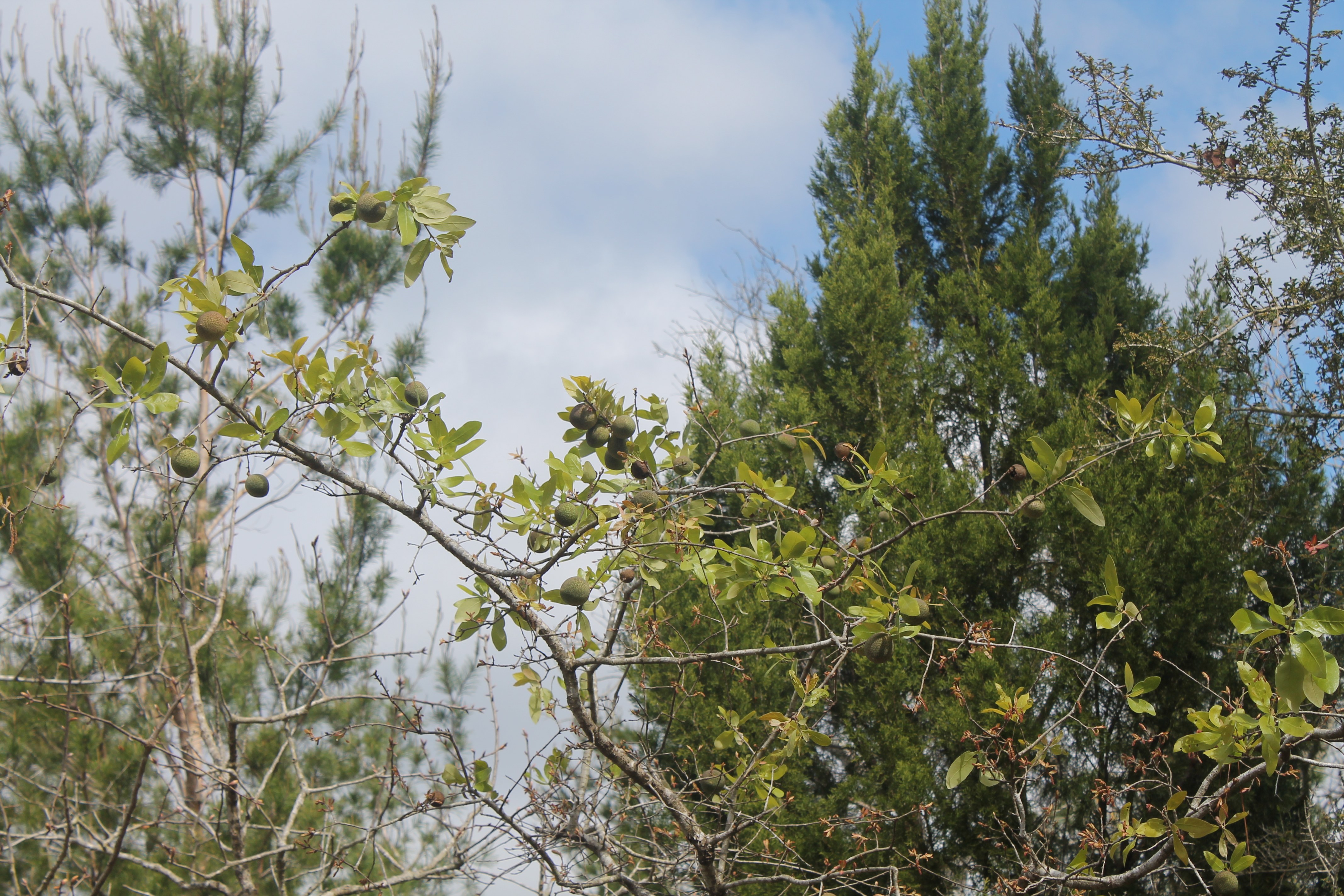
Galls on an immature Water Oak
When the wasp lays eggs on oak leaves, the eggs hatch and larvae cause the leaf tissue to be altered for their purposes. These galls provide shelter and nourishment for the developing larvae until they are ready to emerge and fly out of the center of the gall. It demonstrates a great survival strategy for an otherwise defenseless insect. The adult form of these wasps is no larger in diameter than the thickness of an old fashioned silver coin.
So, the next time you are out in nature and notice something unusual or out of place, it might be an insect gall!!
For additional information please read this excellent article “Oak Apples and the Gall Making Process”, by Joe Boggs at Ohio State University Extension

by Daniel J. Leonard | Jul 20, 2018
Too often, would be gardeners travel to exotic locales, become intoxicated with the beautiful floral display of Plumeria, Jatropha, Bird of Paradise and Bougainvillea, and come home with visions of homemade leis picked from the garden dancing in their heads. As anyone who has attempted to grow any of the aforementioned plants in the Panhandle will tell you though, fulfilling those visions in the landscape are easier said than done! However, not all is lost for the gardener wanting to bring the tropics home. A tropical feel in the landscape can be achieved, you just have to look beyond the aforementioned flowering plants that will have long since succumbed to winter frost by the time they mature and begin flowering and instead to tropical foliage plants that can be enjoyed for a season and easily (cheaply too!) replaced the following spring. Of all the tropical foliage options available for Panhandle landscapes, my favorite is the Ti Plant, sometimes called Hawaiian Ti.
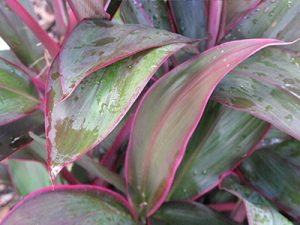
Ti Plant foliage
Even if you have never heard of Ti, you have probably seen it. The strap like, 12-18” long, purple and pink striped leaves are hard to miss and add an unmistakable tropical flair in the landscape! Ti Plants grow generally in single, unbranched stalks, though most commercial growers combine several plants into a single pot to give a bushy, multi trunked appearance that looks more appealing on a retail nursery bench. These plants will easily reach 4-6’ in height in a single warm season, providing a powerful punch of pink/purple all summer long. In addition to its considerable attractiveness, Ti boasts a cosmopolitan constitution, as it will grow in sun or shade, outside or inside. Of course, some cultural do’s apply to Ti broadly, regardless of where it is grown, as well as a few don’ts.
In general, Ti will be more colorful in brighter light. Though it grows well in shade, its leaves tend to lose their luster and fade to a dull purple in full shade. Similarly, though it will survive in full, all day sun, Ti’s foliage tends to bleach a bit in these conditions and can turn a whitish gray. It is best to shoot for somewhere in the middle for the most vivid foliage color. If growing indoors, give Ti as much light as you can. If growing outdoors, full sun through midafternoon is appropriate, as is bright shade throughout the day. Be sure to give Ti plants consistent moisture, as they will readily wilt down under prolonged drought conditions. As with watering, Ti prefers a consistently fertile soil and will appreciate a topdressing of a complete, slow release fertilizer (made by Osmocote, Harrell’s and others) at planting, with a follow up application 60-90 days later (possibly more frequently depending on temperature and frequency of watering).
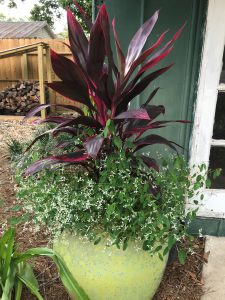
Ti plant in a mixed container – Photo Courtesy Daniel Leonard
Though Ti performs well planted in the ground in Northwest Florida as an annual specimen to brighten a border (think of it like a supersized Coleus), it really gets to shine in large, mixed containers. Ti’s upright growth habit and traffic stopping color make it the perfect thriller in the widely used “thriller, filler, spiller” container design. Because Ti can grow quite large relative to other common container plants, a large 20-45 gallon container is necessary to facilitate optimum root growth and plant development. If a smaller container is chosen, water management will become an issue as the Ti plant’s root mass will quickly crowd the container. I prefer glazed ceramic or concrete containers as these are often painted in bright colors that complement Ti’s foliage, do not allow as much air exchange as terra cotta planters (soil in terra cotta containers dry very quickly in hot, dry weather), and are heavy enough that tall Ti plants won’t cause them to blow over in windy conditions. Mix smaller, mounding filler plants and trailing spiller plants under and around Ti in containers. For a striking contrast in color, choose companion plants in white, yellow, orange or chartreuse (remember, plants don’t have to flower to be colorful, vivid foliage plants like coleus or caladium work too!).
Regardless of how you use Ti Plant, you’ll find it to be one of the most high value color plants in the landscape. Plant one today and happy gardening!
by Mary Salinas | Jul 11, 2018
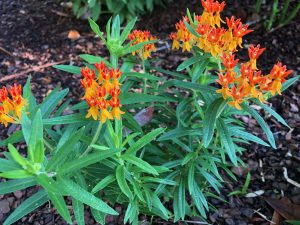
Butterfly Weed – Photo courtesy Mary Salinas
Butterfly weed, Asclepias tuberosa, has been gaining in popularity in the perennials market as it attracts adult butterflies to feed on its nectar and monarch caterpillars to feed on its leaves. Gardeners are also turning to use more Florida native plants in their landscapes.
Independent or native nurseries tend to be the best source for plants but the supply can be quite limited. There are more sources for seed, though, online. Try to purchase seed from a local or Florida grower as those seeds will be better adapted to our climate.
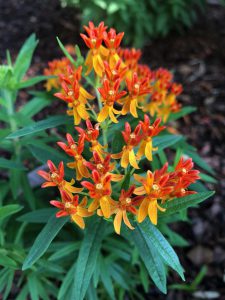
Butterfly Weed – Photo courtesy Mary Salinas
When growing butterfly weed from seed, transplant your new plants into their garden spot when they are still quite young, 2-3” tall, as they will be more successful in getting them established. Choose your planting location wisely. Once you plant it in a particular area, don’t move it. They are finicky about being moved from spot to spot.
For more information:
Monarch Butterfly
Asclepias tuberosa Butterfly Weed, Indian Paintbrush
Florida Wildflower Foundation
by Mark Tancig | Jul 11, 2018
 Guest Post by Leon County Family & Consumer Sciences Agent Heidi Copeland (pictured)
Guest Post by Leon County Family & Consumer Sciences Agent Heidi Copeland (pictured)
With all the rain of late, there seems to be an interest in mycology. You know, the fruiting body of fungi called mushrooms! Edible mushrooms in particular.
It is not unusual; our subtropical summer weather tends to make some fungi flourish! Moreover, apparently, there is a bumper crop of fungi this year. Phone calls to the University of Florida/IFAS Extension office about eating mushrooms has increased. Individuals have even brought mushrooms to the office inquiring if they are of the edible variety.
Our reputation as Extension Agents would certainly be damaged if we did not adhere to a few rules… always read a label, use research-based information, and NEVER tell anyone that a mushroom is edible. It is not that there are not delicious wild mushrooms out there; a recent July 2017, publication of Microbiology Spectrum estimates millions of species. However, even the scientists do not agree as only about 120,000 of them have been described, so far. Not all are edible. Some fungi are poisonous to the point of being deadly.
Matt Smith, an Assistant Professor in the Department of Plant Pathology and the curator of the UF Fungal Herbarium (FLAS) knows a lot about mycology. In fact, he is also the curator of the fungal herbarium managed by the UF Department of Plant Pathology at the Florida Museum of Natural History in Gainesville. The fungal herbarium is a valuable resource and its collections have many important aspects including information about fungi that are deadly poisonous to humans and pets when consumed.
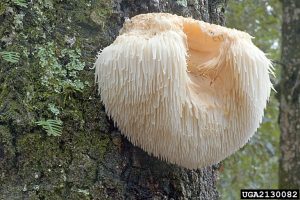
Lion’s Mane mushroom. Credit: Robert Smith; Cabin Bluff Land Management; Bugwood.org
In addition, the UF fungal herbarium is participating in a National Science Foundation-funded project to digitize and database as many US macrofungi collections as possible. This project, the Macrofungi Collection Consortium, includes 34 institutions in 24 states. The project began in July 2012 and will aim to capture data for roughly 1.3 million fungal specimens.
With that said, there is enough scientific research out there to conclude mushroom identification is indeed difficult. Many mushrooms look similar, but are oh so different!
If you are truly interested in eating what you forage MAKE time to study, with experts! Mushrooms, particularly those you plan to eat that are not identified correctly could send you to the emergency room … or worse. The toxicity of a mushroom varies by how much has been consumed. Poisoning symptoms range from stomachaches, drowsiness and confusion, to heart, liver and kidney damage. The symptoms may occur soon after eating a mushroom or can be delayed for six to 24 hours.
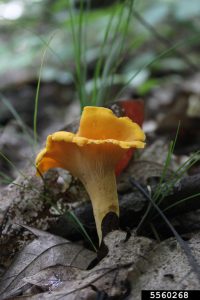
Chanterelle mushroom. Credit: Chris Evans; University of Illinois; Bugwood.org
Delayed symptoms are common. Seek help immediately if you think you may have eaten a poisonous mushroom, even if there are no obvious signs of toxicity. Call the Poison Center’s 24-hour emergency hotline at 1-800-222-1222. You will receive immediate, free and confidential treatment advice from the poison experts.
And if you are determined to make foraging for food a recreational hobby or even want to learn more about what is in your Florida yard, the book Common Florida Mushrooms by University of Florida’s Institute of Food and Agricultural Sciences Emeritus Faculty Dr. James Kimbrough, identifies and describes 268 species of mushrooms found in the sunshine state.
Most importantly, teach your children to NEVER eat any mushroom picked from the ground. It is indeed better to be SAFE than sorry.
People who are interested visiting the fungal herbarium should contact:
Dr. Matthew Smith
email: trufflesmith[nospam]@ufl.edu
by Ray Bodrey | Jul 11, 2018
Rabbiteye Blueberry cultivars are the primary species grown in the Panhandle and are much more popular than the Southern Highbush Blueberry that dominates production further south. Our environment is more hospitable to Rabbiteye; consequently, they tend to be more drought tolerant and less susceptible to disease. The harvest season for Rabbiteye Blueberries is also relatively long. Harvesting can extend from May to July, depending on cultivar selection.
Rabbiteye blueberry season starts to wrap up this month in the Panhandle, as late season cultivars begin their mature fruiting stage. This is also the time of year when we receive seemingly daily afternoon thunderstorms. These frequent rainfall events can compromise blueberry plants over the long term if good management measures are not in place.
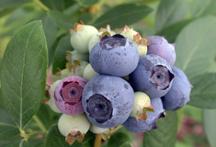
Blueberry. Photo credit: Eric Zamora, UF IFAS.
One of the primary issues experienced with Rabbiteye Blueberry is Phytophthora Root Rot (PRR). This disease is a problem this time of year due to increased rain events and poor draining soils. PRR is caused by the fungus, Phytophthora cinnamomic. Infection by this fungus can lead to plant death if not managed; however, it is a condition that is easier to detect than most diseases. A clear sign of infection is the appearance of symptoms resembling fall color development in the foliage (leaves turning various shades of yellow, orange and red). Foliage color change is followed by leaf drop. A preventative fungicide can be used to treat this condition, but cultural methods (such as transplanting in well drained soils and using at least 3” of pine bark as mulch) will greatly reduce the risk of infection. Remember, blueberries, like azaleas and camellias are also acidic soil loving plants. Soils in the pH range of 4.0-5.5 are necessary for overall plant health and high fruit yields. Pine bark mulch, in addition to improving drainage and organic matter content, will assist in maintaining an acidic pH.
Botrytis Flower Blight or Gray Mold, caused by Botryospheria spp., is another potential issue experienced in late spring/early summer due to lingering moisture. To prevent Botrytis, avoid any overhead watering during the budding and flowering stage or keep watering to the early morning hours so moisture doesn’t linger overnight. Stem Blight can also occur this time of year. Symptoms of Stem Blight are of dying branches, which should simply be removed with sharp shears. There is no chemical control for stem blight and the best defense against this condition is good cultural practices that will in turn reduce plant stress.
In addition to potential fungal diseases, increased summer temperatures and rainfall often also bring an increase in insect populations. Most insecticides that are safe for ornamental landscape plants and fruit crops are safe for blueberries, just be sure to check the label for application rates, directions and precautions. Also, pay close attention to the label for the HI or harvest interval. This is the number of hours or days that need to pass before you can safely harvest fruit once an application of insecticide is made.
For more information on growing blueberries, please contact your local county extension office.
Supporting information for this article can be found in the UF/IFAS EDIS publication, “2017 Florida Blueberry Integrated Pest Management”, by Jeffrey G. Williamson, Phillip F. Harmon, Oscar E. Liburd & Peter Dittmar: http://edis.ifas.ufl.edu/pdffiles/HS/HS38000.pdf
& “Blueberry Gardener’s Guide”, by J. G. Williamson, P. M. Lyrene, and J. W. Olmstead: http://edis.ifas.ufl.edu/pdffiles/MG/MG35900.pdf
UF/IFAS Extension is an Equal Opportunity Institution.











